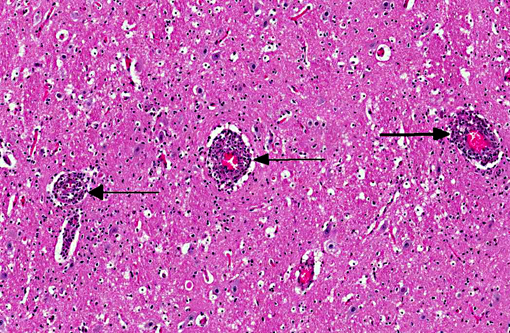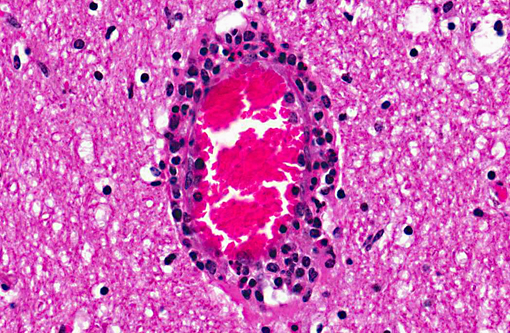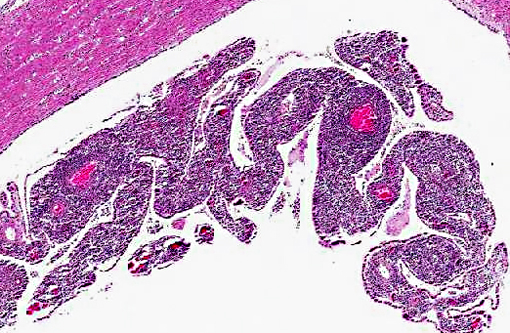Signalment:
Gross Description:
Histopathologic Description:
In most of the sections, there are several vessels in the leptomeninges that have fibrinoid necrosis of the vessel wall. Affected vessels often have adventitial to subintimal accumulation of neutrophils, lymphocytes, and macrophages.
In some sections, choroid plexus is present; it is heavily infiltrated by lymphocytes, plasma cells, macrophages, and neutrophils.
Morphologic Diagnosis:
1. Cerebrum: Vasculitis and perivasculitis, necrotizing, lymphocytic, multifocal, moderate.
2. Cerebrum: Meningoencephalitis, lymphocytic, diffuse.
Lab Results:
Condition:
Contributor Comment:
Typical gross changes associated with MCF include conjunctivitis, cutaneous exanthema, crusting, and alopecia, nasal discharge, oral and esophageal ulcerations, urinary mucosal hemorrhages, and lymphoid enlargement.(2) Mortality in susceptible species approaches 100%; however, in the natural host, infection is latent or inapparent with intermittent virus shedding. These viruses are difficult or impossible to isolate in cell culture.
The common histologic changes associated with MCF are lymphocytic perivasculitis and vasculitis with fibrinoid necrosis of medium sized arteries, and lymphoid hyperplasia.(2) Lesions are characterized by a proliferation of CD8+ T lymphocytes and tissue necrosis.(5,7) The mechanism of proliferation and vasculitis is unknown.(5)
MCF has been documented in white-tailed deer, along with other wild cervids, pigs, and cattle.(1,2,8) Raising bovids and deer around other small ruminants (sheep, goats) can be risky due to transmission of the MCF viruses from the host species that is not clinically ill. The incubation period is usually 2-10 weeks, but may on occasion be very much longer than this. Epizootic hemorrhagic disease (orbivirus) is a differential diagnosis for MCF in deer with acute hemorrhage.
JPC Diagnosis:
Conference Comment:
References:
2. Brown CC, Baker DC, Barker IK. The Alimentary system. In: Maxie MG, ed. Jubb, Kennedy and Palmers Pathology of Domestic Animals, 5th ed. Vol 2. Philadelphia, PA: Elsevier Saunders; 2007:152-158.
3. Li H, Wunschmann A, Keller J, Hall DG, Crawford TB. Caprine herpesvirus-2associated malignant catarrhal fever in white-tailed deer (Odocoileus virginianus). J Vet Diagn Invest. 2003;15:4649.
4. Li H, Dyer N, Keller J, Crawford TB. Newly recognized herpesvirus causing malignant catarrhal fever in white-tailed deer (Odocoileus virginianus). J Clin Micro. 2000;38(4):13131318.
5. Dewals B, Boudry C, Farnir F, Drion PV, Vanderplasschen A. Malignant catarrhal fever induced by alcelaphine herpesvirus 1 is associated with proliferation of CD8+ T cells supporting a latent infection. PLoS ONE. 2008;3(2):e1627.
6. Gasper D, Barr B, Li H, Taus N, Peterson R, Benjamin G, et al. Ibex-associated malignant catarrhal feverâlike disease in a group of bongo antelope (Tragelaphus eurycerus ). Vet Pathol. 2012:49;492.Â
7. Russell GC, Stewart JP, Haig DM. Malignant catarrhal fever: A review. Vet J. 2009;179(3):324-35.
8. Vik+�-+ren T, Li H, Lillehaug A, Jonassen CM, B+�-�ckerman I, Handeland K. Malignant catarrhal fever in free-ranging cervids associated with OvHV-2 and CpHV-2 DNA. J Wildl Dis. 2006;42(4):797-807.


